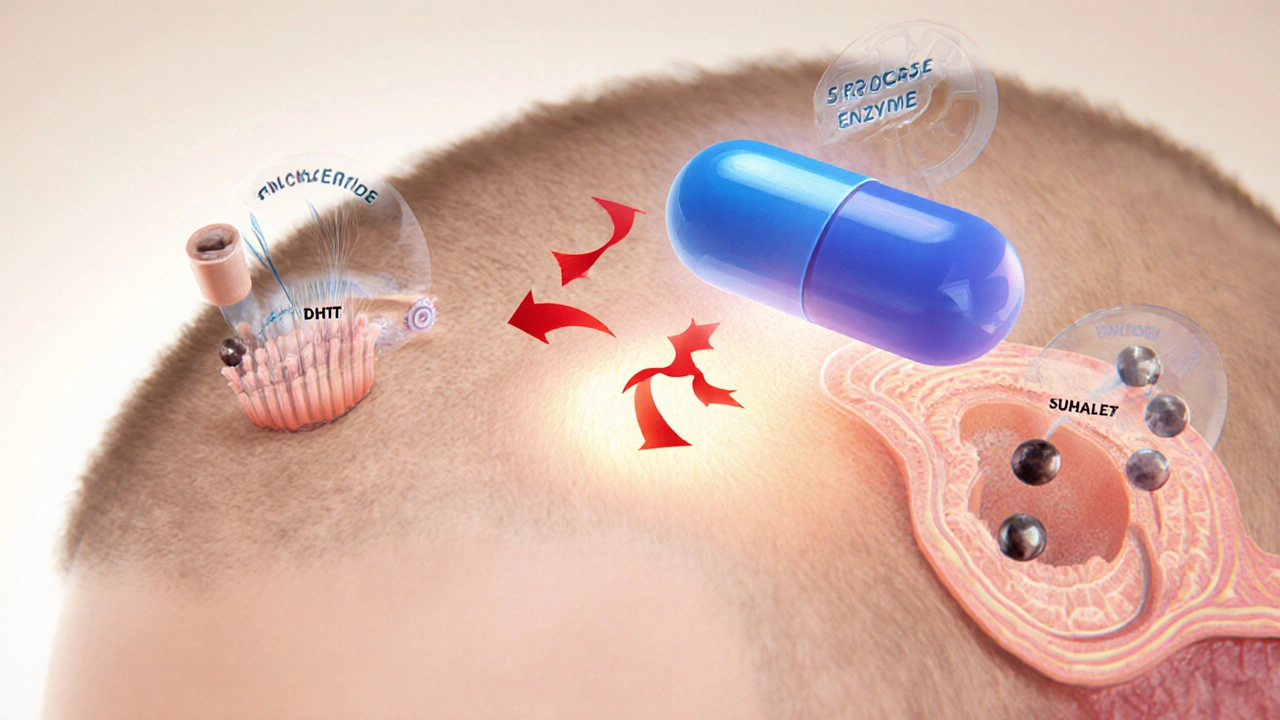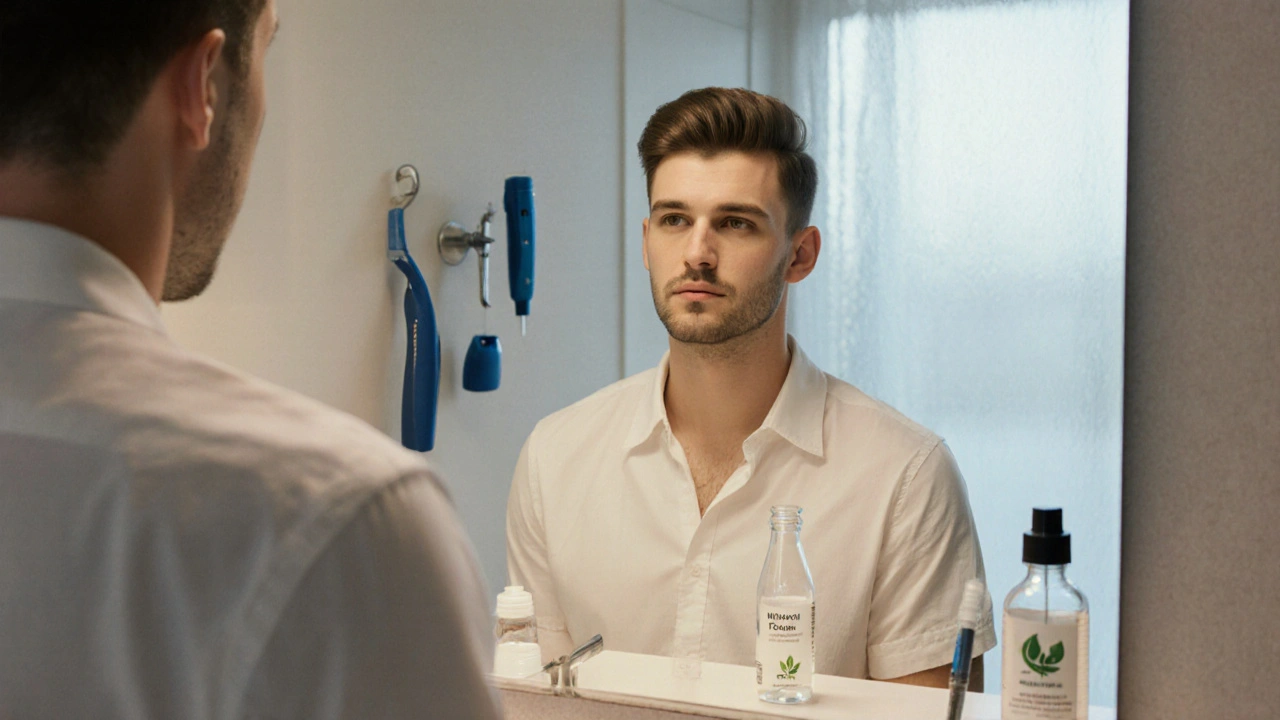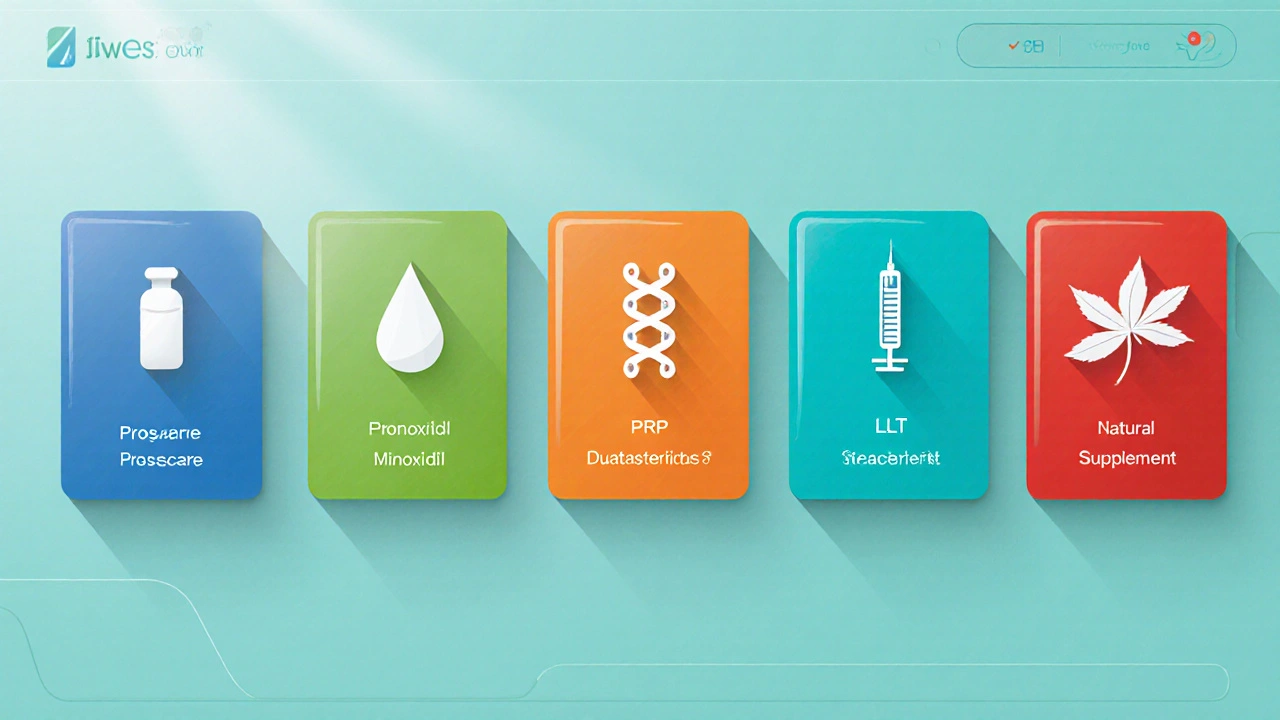Hair Loss Treatment Comparison Tool
Proscare (Finasteride)
Blocks DHT production, 85-90% success rate in stabilizing hair loss.
Side Effects: Decreased libido, ED, breast tendernessMinoxidil
Topical vasodilator, works for early-stage thinning.
Side Effects: Scalp irritation, unwanted hair growthDutasteride
Dual 5α-reductase inhibitor, more potent than finasteride.
Side Effects: Higher sexual dysfunction risk (~12%)PRP & LLLT
Procedural options with modest gains, no systemic side effects.
Side Effects: Minimal, cost variesNatural Supplements
Saw palmetto, biotin, ketoconazole - limited clinical evidence.
Side Effects: Minimal, inconsistent resultsKetoconazole Shampoo
Anti-fungal with anti-androgen properties, reduces scalp DHT.
Side Effects: Scalp irritation, rare systemic effectsTreatment Selection Guide
Recommended Treatment:
Why This Option?
When it comes to battling hair loss, the market is flooded with pills, serums, laser caps and even food‑based supplements. Proscare is a brand‑name finasteride tablet marketed for male pattern baldness. It promises to halt hair‑follicle shrinkage and boost regrowth, but is it truly the best option? Below we compare Proscare with the most common alternatives, weighing efficacy, safety, cost and convenience so you can pick the right route for your scalp.
Key Takeaways
- Proscare (finasteride) blocks DHT production, delivering 85%‑90% success in stabilising hair loss for men.
- Topical Minoxidil a vasodilator applied twice daily works well for early‑stage thinning but adds little for advanced loss.
- Prescription dual‑5α‑reductase inhibitor Dutasteride can be more potent than finasteride, yet carries higher sexual‑side‑effect risk.
- Procedural options like Platelet‑rich plasma (PRP) and Low‑level laser therapy (LLLT) provide modest gains without systemic drugs.
- Natural extracts (saw palmetto, ketoconazole shampoo, biotin) may support results but lack robust clinical proof.
Understanding Proscare (Finasteride)
Finasteride is a 5α‑reductase typeII inhibitor that reduces dihydrotestosterone (DHT) levels in scalp tissue by roughly 70%. The FDA approved a 1mg daily dose for androgenic alopecia in 1997. Clinical trials (e.g., the 5‑year Propecia study) showed that 83% of men on finasteride maintained or increased hair count, while 17% continued to lose hair.
Proscare is simply a generic version of the 1mg tablet, priced lower in many markets. Its benefits include oral convenience and proven long‑term data. Side‑effects can include decreased libido, erectile dysfunction and, rarely, breast tenderness. Most adverse events resolve after discontinuation, but a small subset reports persistent symptoms.
Alternative Medications
Other drug‑based treatments target the same hormonal pathway or improve scalp health through different mechanisms.
- Dutasteride inhibits both typeI and typeII 5α‑reductase enzymes. Dosage typically 0.5mg daily. Studies suggest 1.5‑times greater DHT suppression compared with finasteride, translating to stronger hair‑growth scores, yet sexual side‑effects rise to ~12%.
- Minoxidil a topical vasodilator originally used for hypertension. 5% solution or foam applied twice a day expands blood vessels, boosting follicle size. Works for both men and women; average 10‑12% increase in hair density after 6months.
- Ketoconazole shampoo an anti‑fungal rinse with anti‑androgen properties. 2% or 1% strength used 2-3 times weekly can lower scalp DHT by ~30% and reduce inflammation.
Procedural & Device Options
Non‑pharmaceutical routes appeal to those wary of systemic side‑effects.
- Platelet‑rich plasma (PRP) involves drawing a small blood sample, concentrating platelets, then injecting the concentrate into the scalp. Meta‑analyses (2022‑2024) report a 30‑45% increase in hair thickness after 3‑4 sessions, but costs range €500‑€1500 per course.
- Low‑level laser therapy (LLLT) devices-caps, combs or helmets-emit red light (650‑660nm) that stimulates cellular metabolism. Controlled trials show 15‑25% hair‑count gains after 24weeks, with negligible side‑effects.

Natural & Supplemental Aids
Plant extracts and vitamins are often marketed as gentle allies.
- Saw palmetto is a phytochemical that loosely inhibits 5α‑reductase. Small trials (n≈100) indicate modest DHT reduction, but results are inconsistent.
- Biotin (VitaminB7) supports keratin production. Deficiency leads to brittle hair; supplementation helps only if a deficiency exists.
Side‑Effect Profile Comparison
| Treatment | Common Side‑Effects | Serious Risks (≈% incidence) | Reversibility |
|---|---|---|---|
| Proscare (Finasteride) | Decreased libido, mild erectile dysfunction, breast tenderness | Persistent sexual dysfunction (<1%) | Usually reversible after stop |
| Dutasteride | Similar to finasteride but higher frequency | Sexual dysfunction (up to 12%), potential mood changes | Often improves on discontinuation |
| Minoxidil | Scalp irritation, itching, unwanted facial hair | Rare systemic hypotension | Topical effects stop when use ends |
| PRP | Minor pain at injection sites, swelling | Infection (<0.5%) | Usually resolves quickly |
| LLLT | Transient scalp warmth | None reported | None needed |
Cost & Convenience Overview
Budget often decides which path you take. Below is a quick snapshot of average annual costs (2025 figures) for a typical user:
- Proscare (1mg finasteride): €120-€180 per year (generic pricing).
- Dutasteride: €250-€350 per year.
- Minoxidil 5% foam: €100-€130 per year.
- Ketoconazole shampoo (2%): €70-€90 per year.
- PRP therapy: €800-€1500 for a 4‑session series.
- LLLT device (home cap): €300-€800 one‑time.
- Saw palmetto supplement: €30-€50 per year.
- Biotin 10000µg: €20-€35 per year.
Oral tablets win on convenience-just swallow a pill daily. Topicals demand twice‑daily application, which can be messy. Procedures need clinic visits and recovery time.
Choosing the Right Approach for You
Here’s a simple decision tree:
- If you have moderate‑to‑advanced male pattern baldness and want the strongest evidence‑backed result, start with Proscare (finasteride). Combine with 5% minoxidil for additive effect.
- If you’ve tried finasteride and still see loss, discuss Dutasteride with your doctor-be ready for a higher side‑effect risk.
- For early thinning, especially if you’re hesitant about oral meds, use Minoxidil plus Ketoconazole shampoo. This combo targets both DHT and scalp inflammation.
- If you prefer non‑drug routes, schedule a PRP series or purchase an LLLT device. Consider them as adjuncts rather than stand‑alone cures.
- Supplemental aids like Saw palmetto or Biotin can be added for overall scalp health-but don’t expect dramatic regrowth.
Always consult a dermatologist or trichologist before starting a new regimen, especially when combining systemic drugs.
Practical Tips to Maximise Results
- Take finasteride with food to reduce stomach upset.
- Apply minoxidil to a dry scalp; wait 2‑4hours before using styling products.
- Shave or trim hair before PRP sessions for better platelet penetration.
- Follow LLLT schedule consistently-most protocols recommend 3sessions per week for 24weeks.
- Track progress with monthly photos; hair growth cycles are slow, and visual proof helps stay motivated.

Frequently Asked Questions
Can women use Proscare (finasteride) for hair loss?
Finasteride is not FDA‑approved for female pattern hair loss and can cause birth defects. Some dermatologists prescribe low doses off‑label for post‑menopausal women, but it must be supervised closely.
How long before I see results with finasteride?
Most men notice a slowdown of shedding within 3months, with visible regrowth typically appearing after 6‑12months of consistent use.
Is it safe to combine finasteride with minoxidil?
Yes, the combination is standard practice. They work via separate pathways-finasteride reduces DHT, while minoxidil boosts follicle blood flow-so they complement each other without known drug interactions.
What are the main reasons people stop finasteride?
The most common cause is sexual side‑effects, especially decreased libido. A smaller group stops due to anxiety about long‑term hormone changes or simply because they don’t see dramatic hair growth.
Can I switch from finasteride to dutasteride without a break?
Doctors often transition patients directly, as both inhibit the same enzyme class. However, monitoring for increased side‑effects is advised during the first few weeks.


Pallab Dasgupta
Bro, I tried finasteride for 6 months and lost my sex drive faster than my hairline. Then I switched to PRP and now I look like I’m 25 again. No pills, no drama. Just a few needles and a whole lot of confidence. 🚀
Agastya Shukla
The DHT suppression data for dutasteride is solid - ~90% vs finasteride’s ~70% - but the sexual side effect profile is non-trivial. In clinical practice, I’ve seen 12% incidence of persistent ED even after discontinuation. Not worth the risk unless you’re Grade 3+ Norwood.
Dolapo Eniola
NIGERIA ISN’T WAITING FOR YOUR PHARMA LIES. We’ve been using saw palmetto and black seed oil since our grandfathers’ time. Proscare? That’s a Western scam to sell pills to men who can’t handle their own hormones. Natural > synthetic. Period.
fiona collins
LLLT works. I used a laser cap for 6 months. Not magic. But better than nothing. And zero side effects.
Josh Zubkoff
Look, I get it. You want a miracle. But finasteride is just a Band-Aid on a bullet wound. You’re not 'saving' your hair - you’re chemically suppressing your testosterone to look less like a man. And then you wonder why you’re depressed. The real problem isn’t your scalp - it’s your identity.
Emily Craig
I tried minoxidil for 8 months. Grew a beard. Didn’t grow back my hair. But hey, at least I looked like a lumberjack. 🤡
Rachel Villegas
I’ve been on finasteride for 3 years. My hair is stable. Libido? Slightly down. But I’d rather have a full head than a full libido. No regrets.
giselle kate
Big Pharma doesn’t want you to know that scalp micropigmentation costs $3K and lasts 10 years. They profit off your monthly $50 pill habit. Wake up. You’re being monetized.
Amy Hutchinson
Did you know your hair loss is caused by 5G? I read it on a forum. Also, Proscare is made by the same people who made Roundup. Coincidence? I think not.
Archana Jha
saw palmetto is the real deal!! i took it for 3 months and my hair grew back like a weed!! also i stopped eating dairy and now i’m basically a superhero. you guys just dont get it.
Shivam Goel
The 2022 meta-analysis on PRP? Flawed. 70% of the studies had under 30 participants. Publication bias is rampant. Also, the placebo effect in hair loss trials is insane - people believe they’re getting better because they spent $1K. Confirmation bias meets capitalism.
Aki Jones
Finasteride doesn’t just affect your libido - it alters your brain’s neurochemistry long-term. There are case reports of permanent anhedonia. The FDA approved it in 1997. Why? Because they were bribed. The pharmaceutical industrial complex is a cancer.
Jefriady Dahri
I’ve been doing LLLT + ketoconazole shampoo for 10 months. My hair’s thicker, my scalp doesn’t itch, and I feel like I’m finally taking care of myself. No drama. Just consistency. You got this 💪
Andrew McAfee
In the U.S., we treat hair loss like a crisis. In India, men just wear caps. In Japan, they use traditional herbs. Maybe the real issue isn’t the hair - it’s how we’ve been taught to fear aging.
Andrew Camacho
I’m not saying finasteride is evil. But have you ever met a guy on it who doesn’t talk about his ‘hormonal balance’ like he’s in a cult? It’s not treatment - it’s a lifestyle brand now. #FinasterideLife
Arup Kuri
If you’re still using minoxidil, you’re wasting your time. It’s just a vasodilator that makes your scalp red and itchy. Real men use dutasteride. Or nothing. But never that liquid garbage.
Karen Willie
Whatever works for you is right. No shame in PRP. No shame in saw palmetto. No shame in going bald. You’re not broken. Your hair doesn’t define your worth.
Leisha Haynes
I switched from finasteride to dutasteride because I wanted more hair. Got more hair. Also got a partner who left because I was emotionally flat. So… congrats? I guess I won? 😌
Ellen Sales
I used to think hair loss was a medical problem… until I realized it was a cultural one. We’re told to fear aging, to chase youth, to spend money to look like someone else’s version of success. What if the real cure was… letting go?